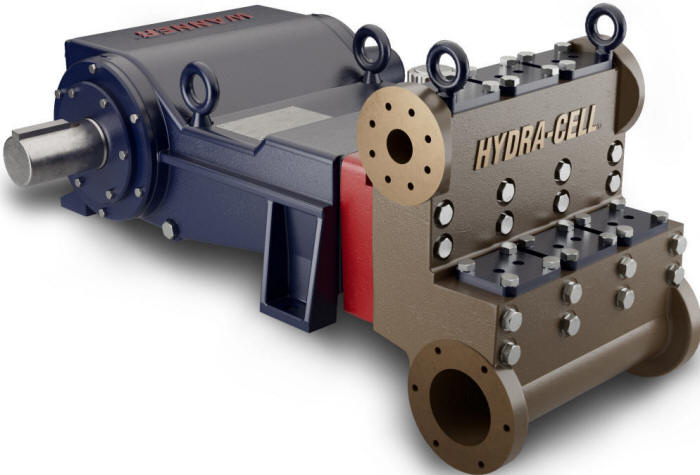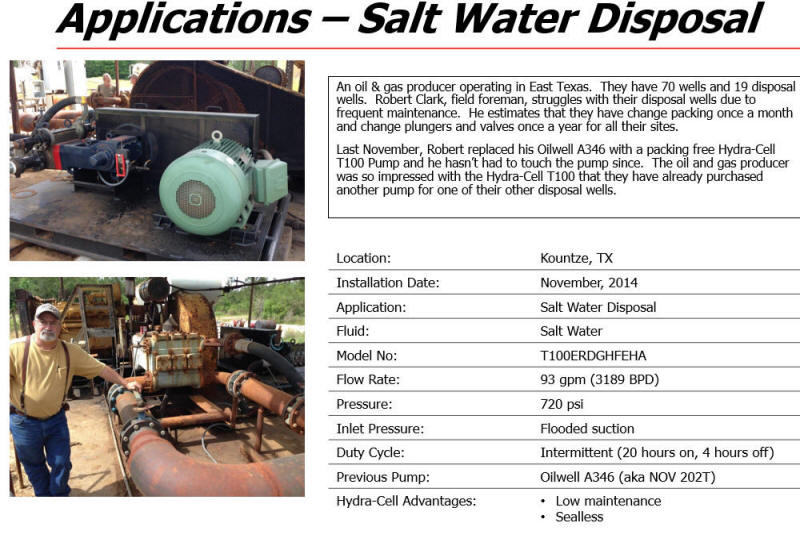Wanner™ Hydra-Cell® Pro T60 Pump - Advanced Efficiency and Reliability
Call us at 908.362.9981 to speak with a sales engineer or Send us an inquiry
 Introducing
the latest pump model in the Wanner™ T Series Hydra-Cell® Pro Pump
model line, the model T60. The T60 pump bridges the gap in flow
rates between the model D66 (65 GPM @ 1000 PSI) and the T100
(capable of 96 GPM @ 2100 PSI).
Introducing
the latest pump model in the Wanner™ T Series Hydra-Cell® Pro Pump
model line, the model T60. The T60 pump bridges the gap in flow
rates between the model D66 (65 GPM @ 1000 PSI) and the T100
(capable of 96 GPM @ 2100 PSI).
T Series Wanner
Hydra-Cell Pro Pumps
This is the asynchronous positive
displacement pump version of Wanner’s sealless pump product line.
Prior to the introduction of the T60, the T series pumps tended to
target higher flow rate and pressure applications (within the 10 to
100 GPM and >1500 PSI range). This is in contrast to their
synchronous design D/G/P series pumps, which are utilized for lower
flow rates to maximize pumping efficiency and accuracy; these are
applied for flow rates as low as 0.06 GPH to as high as 65 GPM and
typically at pressures <1000 PSI. Thus, the T60 is providing access
to higher flow rates without being “overbuilt” for applications
requiring <1000 PSI.
Features and Specifications for
the T60 Hydra-Cell Pro Pump
- Approximately 9.4 to 94 GPM at 60 to 600 RPM
- Discharge pressures from 30 to 1000 PSI
- Maximum inlet pressure of 500 PSI
- Left- or Right-side drive shaft
- Uni-directional shaft rotation
- NPT or ANSI flanged inlet/outlet ports
Comparison to Plunger Pumps
The #1 difference is the patented sealless design which significantly
improves reliability and lowers cost of ownership. Plunger pumps have a
dynamic seal, meaning the piston displacing the pumped liquid passes through
a physical seal to prevent the pumped liquid from entering the oil
lubricated side of the pump (the “hydraulic end”). The friction between the
piston/plunger and its seal results in wear; such wear is accelerated when:
- Particulate is present in the pumped liquid
- Non-lubricating liquids are pumped
- Liquid temperatures are extreme
- The pump operates dry, during priming/start-up, shut down or system upsets
The Hydra-Cell Pro Pump has a non-dynamic seal
between the liquid and hydraulic ends of the pump, thus wear otherwise
associated with #1-4 above is non-existent. Perhaps the two most important
aspects of the Wanner design are:
- The level of filtration required to protect the pump is significantly reduced and for the T60 it is only 800 microns whereas the IOM manuals for triplex plunger pumps recommend filtering to 10 microns!
- Zero fugitive emissions: the pumped liquid is wholly contained within the pump head, thus no environmental contamination or volatile emissions as is the case with worn/leaky plunger/piston seals.
Our article Comparison of a Hydra-Cell pump to Piston and Plunger pumps provides a in-depth comparison of both designs.
Required Maintenance
Both
T60 and comparable tri-plex plunger pumps have check valve assemblies which
require periodic replacement due to wear. Likewise, both require periodic
oil changes and although the T60 contains about double the volume of
hydraulic oil as a CAT 6760 requires (5 gallons vs 2.5 gallons), the T60
uses generic 10W30 synthetic oil with changes at 500 hours initially and
every 2000 hours (or 6 months) thereafter. The CAT pump recommends using
their proprietary oil, initially changed after the 1st 50 hours and then
every 500 hours thereafter. Thus, over the course of 1 year of continuous
duty operation the T60 would require 25 gallons of 10W30 oil whereas the CAT
pump requires 43.75 gallons of their special (and expensive) multi-viscosity
ISO68 oil.
Since there are no packing or seals used in T60 pumps, the
cost and labor associated with seal repairs only applies to the CAT design.
Such maintenance requires removing the pump head and it is neither quick nor
inexpensive to replace seals/plungers.
Operational Savings
Wanner surveyed a customer whom started replacing their Plunger pumps with T
series Hydra-Cell Pro pumps and documented the operational savings per pump:

Often only the initial purchase cost is considered
but as illustrated above the operational and maintenance costs can exceed
the initial pump cost significantly.
Applications for Wanner’s asynchronous sealless
positive displacement pumps include:

These applications represent various
characteristics for which the Hydra-Cell design is superior to a packed
plunger pump design. Remote locations benefit greatly from increased
reliability and pumping hazardous liquids without fugitive emission/leakage
result in reduced operational and maintenance costs.

Wanner’s T & Q series asynchronous style pumps are
replacing the following brands of piston/plunger pumps; some (Bethlehem,
Oilwell, Ajax, Kerr, Kobe, Weatherford) no longer manufacture piston and
plunger pumps and users are forced to have custom parts made to maintain
their pumps. The other manufacturers offer pumps that fall within the Wanner
T series product line and those customers would realize operational cost
reductions by upgrading to the Hydra-Cell Pro design:

Factors for Replacing Piston/Plunger Pumps

Customers are often not proactive in replacing
outdated pump designs, usually such pumps are run to failure and oftentimes
repairing the pump might be the quickest way to get back on-line. Often it
takes repeated failures which significantly increase downtime and
maintenance costs to “encourage” a customer to seek alternatives.
Please keep the Wanner Hydra-Cell Pro sealless pumps in-mind for any high
maintenance pumping application, especially if it involves pump models or
brands no longer in production.
Additional Information




